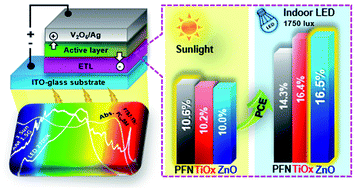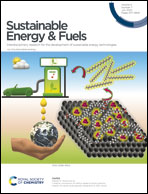A cathode interface engineering approach for the comprehensive study of indoor performance enhancement in organic photovoltaics†
Abstract
Organic photovoltaics (OPVs) have a promising future in reliable energy harvesting to drive low power consumption devices for indoor applications. In this article, the outdoor (1 sun) and indoor (2700 K LED) performance of an inverted OPV, PTB7-Th:PC70BM, with three different solution-processed electron transport layers (ETLs = PFN, TiOx, and ZnO) was compared. The morphological, optical, and electrical measurements indicated the strong dependency of the OPV performance on the illumination conditions. The sample with PFN-ETL showed the highest outdoor performance with a power conversion efficiency (PCE) of 10.55% and the best reported fill factor (FF) of 75.00% among the PTB7-Th:PC70BM-based OPVs; surprisingly, it exhibited the lowest performance when illuminated under 250–2000 lux 2700 K LED light. Meanwhile, the lowest outdoor performance was demonstrated by ZnO with a PCE of 10.03%; it displayed the best indoor performance with a PCE of 13.94% under 1000 lux LED light and a PCE of up to 16.49% under 1750 lux LED light. The changes in the FF values could be estimated by incorporating the parasitic resistance effect due to the type of ETL used. Additionally, using impedance spectroscopy, we observed that the indoor performance agreed well with the trend of the charge collection efficiency.



 Please wait while we load your content...
Please wait while we load your content...